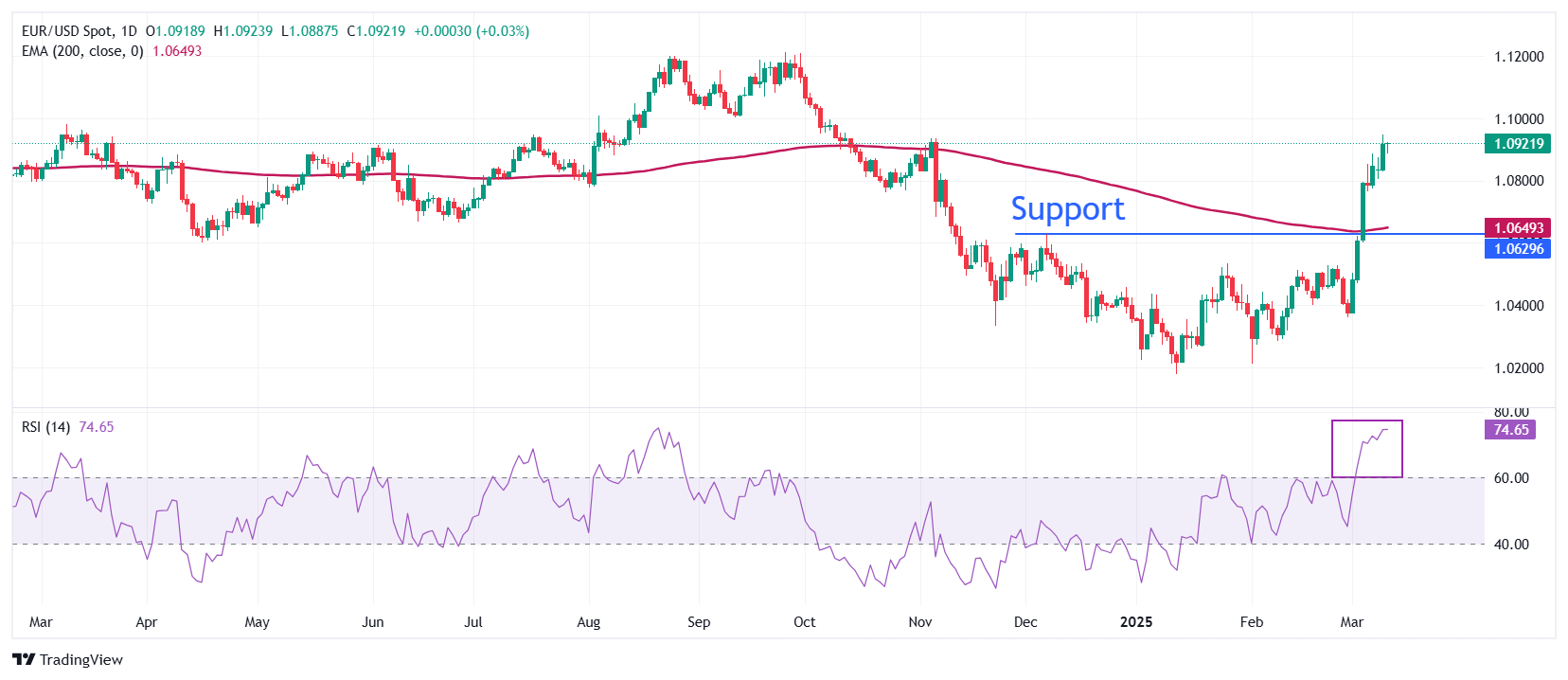- EUR/USD holds firm near 1.0900 as US recession concerns weigh on the Dollar.
- US Commerce Secretary Lutnick defends President Trump’s policies, despite potential recession risks.
- The Euro strengthens on optimism over a 30-day Ukraine ceasefire and Germany’s debt restructuring plans.
EUR/USD remains steady around 1.0920 during North American trading hours on Wednesday following the release of the US Consumer Price Index (CPI) report for February. The data revealed that inflationary pressures eased more than expected, reinforcing market expectations of a Federal Reserve (Fed) rate cut in May.
Headline inflation on a yearly basis slowed to 2.8%, below the anticipated 2.9% and January’s 3% increase. Meanwhile, core CPI—excluding food and energy—rose 3.1%, lower than the forecasted 3.2% and the previous 3.3%. On a monthly scale, both headline and core CPI increased moderately by 0.2%, compared to the projected 0.3%.
As a result, the US Dollar Index (DXY), which tracks the Greenback’s performance against six major currencies, struggles to maintain its four-month low at 103.20.
The US Dollar (USD) has been under pressure as concerns grow over President Donald Trump’s tariff policies and their impact on economic stability. Investors worry that his "America First" stance could further fuel inflation, eroding household purchasing power.
Recession fears escalated on Tuesday after US Commerce Secretary Howard Lutnick defended Trump’s policies in a CBS interview, stating, “These policies are the most important thing America has ever had, and they are worth it,” even if they result in an economic downturn.
Market Movers: EUR/USD Gains Strength from German Policy Developments and Ukraine Ceasefire Hopes
-
Euro Strengthens on German Defense Spending Talks: EUR/USD has been rallying for over a week, buoyed by optimism over Germany’s potential debt restructuring to increase defense spending. Talks between Green Party leader Franziska Brantner, expected Chancellor Friedrich Merz, and Social Democratic Party (SDP) co-leader Lars Klingbeil on Thursday could pave the way for a policy shift that supports economic growth. A looser German “debt brake” could be a game-changer for the Eurozone, potentially forcing the European Central Bank (ECB) to reconsider its dovish stance.
-
Optimism Over Ukraine Ceasefire Lifts the Euro: Hopes for de-escalation in Ukraine have boosted investor sentiment. On Tuesday, Ukraine agreed to an immediate 30-day ceasefire during a meeting with US officials in Saudi Arabia. US Secretary of State Marco Rubio will now present the proposal to Russia. During European trading hours on Wednesday, the Kremlin responded cautiously, stating they need to hear from US National Security Advisor Mike Waltz and Secretary of State Rubio before commenting on whether the ceasefire terms are acceptable.
-
US Tariff Policies Pose a Challenge for the Euro: While the Euro benefits from geopolitical developments, Trump’s tariff strategy continues to cast uncertainty. On Tuesday, Canada’s Ontario Premier Doug Ford reversed a 25% surcharge on electricity exports to the US after Trump threatened to raise tariffs on Canadian steel and aluminum imports to 50%, demonstrating his aggressive trade negotiation stance.
Technical Analysis: EUR/USD Targets Stability Above 1.0900
EUR/USD remains firm near 1.0900, holding within Tuesday’s trading range. The pair extended its rally after a decisive breakout above the December 6 high of 1.0630 last week. The long-term outlook remains bullish, as the currency pair is well above the 200-day Exponential Moving Average (EMA), currently at 1.0650.

The 14-day Relative Strength Index (RSI) has surged near 75.00, signaling strong bullish momentum.
Key Levels to Watch:
- Support: December 6 high of 1.0630
- Resistance: Psychological barrier at 1.1000
With inflation cooling and the Fed leaning towards a dovish stance, EUR/USD remains positioned for further upside, contingent on upcoming economic data and geopolitical developments.





